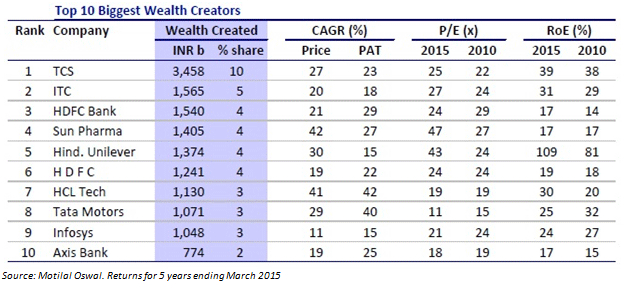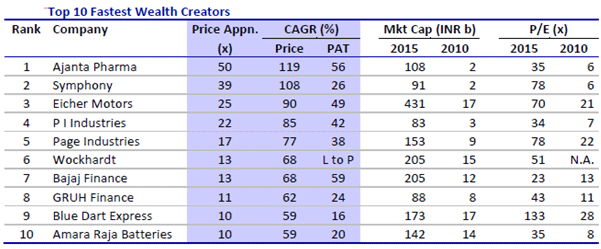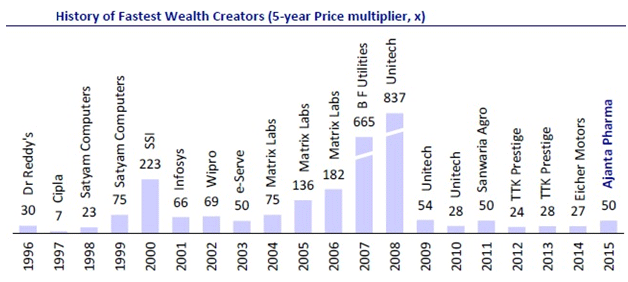Motilal Oswal has come out with its 20th Annual Wealth Creation Study for five years between 2010 and 2015. We only thought it apt to not just showcase the results of that report, but to also let you know how these findings play a vital role in your own mutual fund portfolios and investing habits as well. After all, your equity mutual fund portfolios are nothing but a basket of stocks, meticulously picked by fund managers, in the hope that they build your wealth.
The report splits its findings into various segments. Of these, we will discuss the ‘biggest wealth creators’ and the ‘fastest wealth creators’. Wealth creation is defined by the addition (in value) to market cap in the last 5 years. Market cap growth and price returns are for the 5 years ending March 2015.
Elephants too dance
The table below showcases the top 10 wealth creators. Needless to say, they are large-sized companies with significant growth in their market cap in the last 5 years. Do note that it is not just the increase in market cap; the returns (column called ‘Price CAGR %’) is by no means small. And do note that markets, over the long term, are slaves only to earnings growth. You will notice that these companies had double-digit earnings growth delivered over this period. This is no mean task, given that these are large companies with an already high earnings base.
Takeaway: Of course, this is not to say that you should expect equity funds to deliver likewise. They likely won’t. Do not forget that a fund basket is a mix of good and mediocre picks; only perhaps better than a portfolio that a novice investor would construct.
The point here is that large-cap stocks too deliver, and more importantly, deliver consistently. In this list, for instance, the top 3 stocks were consistent wealth creators in Motilal Oswal’s past reports as well; that means they generated wealth in the previous 3 blocks of 5 years. Large-cap stocks, with their dominant position, are able to not only withstand slow down, but are also ready to take off when the revival happens. This reflects clearly in their earnings growth.

The low base effect
Needless to say, small companies have managed to grow their market cap at a much faster clip, generating superlative returns in the process. It is a small wonder that you see your mid-cap and small-cap funds deliver high returns. However, the key here is to be able to catch them all at the right time; and this is no easy task.
Besides, the ability of these stocks to deliver consistently is also low. For instance, according to the report, in the table below (top 10 fastest wealth creators), only Eicher Motors and Page Industries managed to appear in this list in the past 3 years (for every block of 5 years). That means, there are always new companies coming up.

Just take a look at the data below to see the 5-year fastest wealth creators in different years. That means, unless you had entered these stocks in the right years, you may not land up with a multi-bagger. Not an easy task even for a fund manager, right? And the larger risk is that smaller companies’ stocks are prone to high mortality. Take the case of Sanwaria Agro (wealth creator for 5 years ending March 2011). From its rise between 2006 and 2011, the stock plummeted 85 per cent for 5 years ending March 2015.

Takeaway: Mid and small-caps are necessary to provide pace to your wealth creation. However, their high mortality, and need to time their entry and exit proves it extremely difficult to enjoy their growth story in a sustained way, save for a few stocks.
Why is this so? According to the report, this segment of market cap needs a ‘Lollapalooza effect’ to occur. This term, used by Charlie Munger of Bershire Hathaway and partner of Warren Buffett, simply means that real big outcomes arise when multiple factors are at play. For instance, size, quality, growth, longevity, and price may have to act together for a stock to raise to meteoric proportions. There are also some fundamental factors that become essential.
For instance, many of the companies in the fastest wealth creator list were in large sectors such as finance, autos, or pharma, or in scalable niche businesses such as air coolers (Symphony), or inner wear (Page Industries). These, combined with sound management and proper handling of financial resources, can lead to high pace of earnings growth, and in turn, drive evaluations.
That’s a lot to deal with isn’t it? Some of you may be enamoured by the returns generated by mid and small cap funds (and their stocks), and you may enter them after a huge run up. Do remember that the run up simply implies that a good number of stocks in that segment may be highly valued.
Take a look at the table (Top 10 fastest wealth creators) and you will see that the price earnings ratio of these stocks are at a premium that makes it hard for earnings growth to move at the same pace. Hence, stagnation, lower returns, or sometimes, even a price fall cannot be ruled out. As opposed to this, you will see better parity in the valuation of larger companies (first table) when compared with their earnings growth.
This is why we think it is good to have mid-caps, but not too much. Large and emerging large caps, through large-cap and diversified funds, should provide the necessary stability; even as mid-cap funds generate a few winners.
Other takeaways
The report has plenty of other takeaways, a few of which we enlist:
- Wealth is created through buying and holding – good opportunities that is. This holds true for mutual funds as well.
- However, buy and hold has an expiry date too. To be able to identify when a stock is nearing its high-growth expiry date, or a fund is slipping in performance requires periodic monitoring and review.
- Chasing chart busters seldom yields results.
- It is hard for mid-cap stocks, and therefore, mid-cap funds to sustain performance. While stocks may have to be exited at the right time (even if early), mid-cap funds have to deftly rejig their portfolio to identify new opportunities. If not, they fall by the way side in the performance chart.
- Short term wealth destruction cannot be prevented in downturns; such times can, however, be well used to average costs in otherwise sound stocks/funds.
FundsIndia’s Research team has, to the best of its ability, taken into account various factors – both quantitative measures and qualitative assessments, in an unbiased manner, while choosing the fund(s) mentioned above. However, they carry unknown risks and uncertainties linked to broad markets, as well as analysts’ expectations about future events. They should not, therefore, be the sole basis of investment decisions. To know how to read our weekly fund reviews, please click here.









but real concern for investor is – this growth isn’t reflecting in mutual fund returns.
What is avg CAGR of large cap funds for last 05 yrs : around 7%.
Thanks.
Hello Sir, the 5-year return you are talking of is a mere point to point market return of Sensex. Good funds have delivered anywhere between 12-20% annual returns over 5 years. And SIPs have delivered even higher as a result of cost averaging. If it is not reflecting in your mutual fund then either the fund has to be reviewed or the strategy (lump sum or SIP) has to be. True, mutual funds cannot deliver as well s individual stock winners. Afterall, nobody can pick a portfolio of 30/30 or 40/40 winning stocks! thanks, Vidya
but real concern for investor is – this growth isn’t reflecting in mutual fund returns.
What is avg CAGR of large cap funds for last 05 yrs : around 7%.
Thanks.
Hello Sir, the 5-year return you are talking of is a mere point to point market return of Sensex. Good funds have delivered anywhere between 12-20% annual returns over 5 years. And SIPs have delivered even higher as a result of cost averaging. If it is not reflecting in your mutual fund then either the fund has to be reviewed or the strategy (lump sum or SIP) has to be. True, mutual funds cannot deliver as well s individual stock winners. Afterall, nobody can pick a portfolio of 30/30 or 40/40 winning stocks! thanks, Vidya